Unusual
Snow Crystals
... Some exotic examples from the snow crystal menagerie ... |
|
In addition to the normal
snowflake forms (see Guide to Snowflakes),
there are also many unusual shapes that can be found floating from the sky. Some of
these are described here, with photos from the Rasmussen&Libbrecht collection (see Photo Collections).
And, of course, you can find even more in our new book.... |
| Not
Your Ordinary Snow ... |
 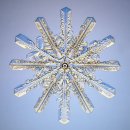 12-Sided Snowflakes 12-Sided Snowflakes
A bit of snowflake watching may turn up some 12-sided
snowflakes, as these occur along with the normal 6-sided variety. They're not real common,
but you can spot them if you look. Some snowfalls bring quite a few twelve-siders,
although no one really knows what weather conditions are best for making them.
|
 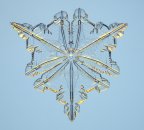 Triangular Snowflakes Triangular Snowflakes
You won't find any 4-, 5-, or 8-sided snowflakes in the wild, but you may spy
some 3-sided crystals. As with the 12-siders, these crystals appear along with the
more common hexagonal variety. And again, their origin is still something of a
mystery.
|
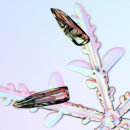 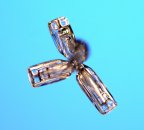 Bullets Bullets
Bullets form when several columnar crystals grow from a single nucleus, a
beginning that is similar to the spatial dendrites (see Guide to Snowflakes).
Bullets always start out in clusters, but the clusters can break up to yield
individual bullet crystals. |
  Arrowhead Crystals Arrowhead Crystals
Crystal twinning is a phenomenon whereby two crystals grow out
of a single seed and have a specific crystallographic orientation relative to one another.
One example is found in arrowhead crystals, which occur along with
columns. The unusual shape results from the way the two crystal halves are joined.
The seam between the crystals can be seen when some of the ice evaporates,
leaving an evaporation groove, as indicated in the picture at right. |
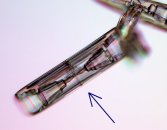 Twin Prisms Twin Prisms
Another example of crystal twinning occurs when twin columns grow from a
common center, one rotated 60 degrees relative to the other. The growth looks like
an ordinary column, but again we can find an evaporation groove that indicates twinning.
Twelve-sided snowflakes also form by columnar twinning; in this case the two
columns are rotated 30 degrees and the assembly grows into a capped column (see Guide to Snowflakes). |
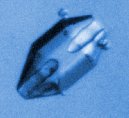 Pyramidal Crystals Pyramidal Crystals
At very low temperatures one can find snow crystals with
pyramidal facets in addition to the usual basal and prism facets (see the Snow Crystal
Primer) (photo from Tape [1]). Sometimes seen at the South Pole, these crystals
are exceedingly rare in more benign climates.
|
|
| [1] W. Tape, Atmospheric Halos,
Antarctic Research Series, Vol. 64, (American Geophysical Union, 1994). |
